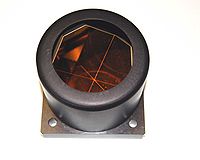
Photo from wikipedia
Lunar laser ranging has made significant contributions to the study of gravitational physics and the Earth-Moon system. The best results for fundamental gravitational experiments have been achieved using lunar laser… Click to show full abstract
Lunar laser ranging has made significant contributions to the study of gravitational physics and the Earth-Moon system. The best results for fundamental gravitational experiments have been achieved using lunar laser ranging data accumulated so far. However, corner cube retroreflector arrays placed on the Moon currently set a limit on the laser-ranging precision, which is approximately several centimeters for a single photon received. To achieve millimeter precision, next generation of lunar laser ranging using a single hollow retroreflector with a large aperture has been proposed. We developed a prototype hollow retroreflector with a 100-mm aperture using silicate bonding together with a new fabrication method. Dihedral angle offsets of 0.5'', 0.8'' and 1.9'' were realized, which partly come close to meeting the requirements (offset of 0.6'' for each dihedral angle) for lunar laser ranging. Fluctuation of the wavefront is approximately 1.038λ at 633 nm. A thermal cycle test ranging from −40°C to +75°C was carried out for 18.5 periods (approximately 5 d). After this test, the dihedral angle offsets were measured to be 0.39'', 1.00'' and 2.06''. The results indicate the potential application of our method for manufacturing a hollow retroreflector with a large aperture to realize lunar laser ranging.
Journal Title: Research in Astronomy and Astrophysics
Year Published: 2018
Link to full text (if available)
Share on Social Media: Sign Up to like & get
recommendations!